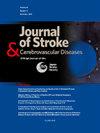The hidden cost of being uninsured: Stroke mortality after mechanical thrombectomy
IF 1.8
4区 医学
Q3 NEUROSCIENCES
Journal of Stroke & Cerebrovascular Diseases
Pub Date : 2025-07-01
DOI:10.1016/j.jstrokecerebrovasdis.2025.108387
引用次数: 0
Abstract
Introduction
The impact of insurance status on mortality and functional outcomes has yet to be examined in Mechanical Thrombectomy (MT) patients, despite research on socioeconomic status.
Objective
Herein we describe the effects of insurance status on MT outcomes while controlling for other components of socioeconomic status like race, gender, and area deprivation index (ADI).
Methods
We performed a retrospective cohort study of 395 patients undergoing MT at a single comprehensive stroke center between 2018 and 2022. Patients were grouped based on presence of insurance on admission. Univariate and multivariate analysis were conducted examining the following outcome variables: length of stay (LoS), readmission within 90 days, good functional outcomes measured as a modified Rankin score at 90 days<3, and death.
Results
A total of 44/395 (11.1 %) patients were uninsured. Uninsured patients were significantly younger on average (59.5 ± 18.2 years compared to 67.1 ± 14.7 years (p = 0.010)) On multivariate analysis, insured status was associated with improved mortality rates (OR: 0.33; 95 % CI: 0.11-0.93; p = 0.035). On univariate analysis, insured status did not have a significant effect on favorable functional outcome (OR:1.15; 95 % CI:0.56-2.34; p = 0.70), LoS (OR:1.23; 95 % CI:0.66-2.32; p = 0.511) or readmission rate (OR:1.66; 95 % CI:0.38-7.31; p = 0.50). Discharge disposition neared significance, with 50 % of insured patients being discharged to a rehabilitation facility, while only 29.3 % of uninsured patients were discharged similarly (p = 0.06).
Conclusion
Lack of insurance is associated with increased mortality following MT after controlling for other socioeconomic variables and may be an important marker of outcomes in AIS patients.
未投保的隐性成本:机械血栓切除术后的中风死亡率。
导言:尽管对社会经济地位进行了研究,但保险状况对机械取栓(MT)患者死亡率和功能结局的影响尚未得到检验。目的:本文在控制种族、性别和地区剥夺指数(ADI)等社会经济地位的其他组成部分的情况下,描述了保险状况对MT结果的影响。方法:我们对2018年至2021年间在单一综合卒中中心接受MT治疗的395例患者进行了回顾性队列研究。患者根据入院时是否有保险进行分组。单因素和多因素分析植入检查以下结果变量:住院时间(LoS), 90天内再入院,90天时改良Rankin评分测量的良好功能结果。结果:共有44/395(11.1%)患者未投保。未参保患者的平均年龄明显更年轻(59.5±18.2岁比67.1±14.7岁(p=0.010))。在多因素分析中,参保状态与死亡率的改善相关(OR: 0.33;95% ci: 0.11-0.93;p = 0.035)。在单变量分析中,参保状态对良好的功能结局没有显著影响(OR:1.15;95%置信区间:0.56—-2.34;p=0.70), LoS (OR:1.23;95%置信区间:0.66—-2.32;p=0.511)或再入院率(or:1.66;95%置信区间:0.38—-7.31;p = 0.50)。出院处置接近显著性,50%的参保患者出院到康复机构,而只有29.3%的未参保患者出院相似(p=0.06)。结论:在控制其他社会经济变量后,缺乏保险与MT后死亡率增加有关,可能是AIS患者预后的重要标志。
本文章由计算机程序翻译,如有差异,请以英文原文为准。
求助全文
约1分钟内获得全文
求助全文
来源期刊

Journal of Stroke & Cerebrovascular Diseases
Medicine-Surgery
CiteScore
5.00
自引率
4.00%
发文量
583
审稿时长
62 days
期刊介绍:
The Journal of Stroke & Cerebrovascular Diseases publishes original papers on basic and clinical science related to the fields of stroke and cerebrovascular diseases. The Journal also features review articles, controversies, methods and technical notes, selected case reports and other original articles of special nature. Its editorial mission is to focus on prevention and repair of cerebrovascular disease. Clinical papers emphasize medical and surgical aspects of stroke, clinical trials and design, epidemiology, stroke care delivery systems and outcomes, imaging sciences and rehabilitation of stroke. The Journal will be of special interest to specialists involved in caring for patients with cerebrovascular disease, including neurologists, neurosurgeons and cardiologists.
 求助内容:
求助内容: 应助结果提醒方式:
应助结果提醒方式:


